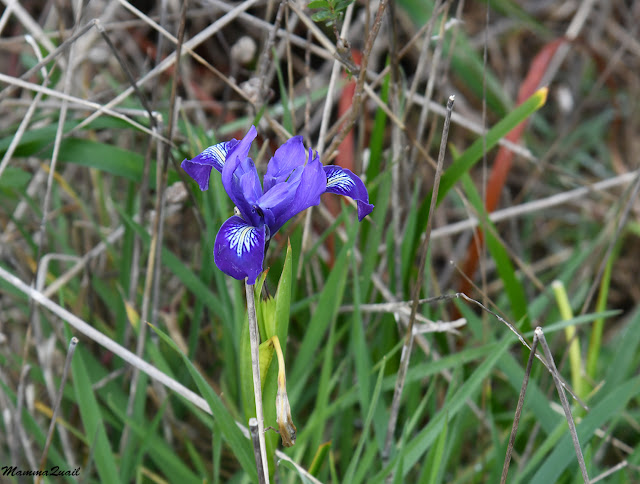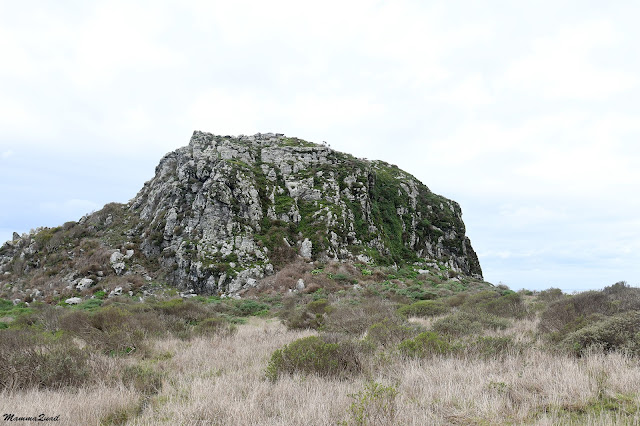Date: February 18, 2024
Place: Sonoma Coast State Park, Jenner, California
Coordinates: 38.430969, -123.109415
Length: 1.6 miles
Level: moderate
On Presidents Day weekend Pappa Quail and I went on a trip to the Russian River on our own, leaving the chikas to care fr the home and the pets. The stormy forecast didn't stop us from hiking at Armstrong Redwoods State reserve on our first day. The morning of our second day was actually sunny and relatively calm and we enjoyed a nice hike at Goat Rock Beach in Sonoma Coast State Park. After the beach exploration hike we drove up Goat Rock Road to the trailhead of Kurtum Trail, where we thought of going on our next hike.
It didn't rain yet, but the clouds were gathering still and the day was darkening. The trail we started down on was soggy and seeping. Thankfully, it has also grown a mat of freshly sprouted vegetation so for the most part the mud was not exposed.
 |
| Kurtrum Trail |
Right away we started seeing wildflowers, spring ephemeral such as the milkmaids. I could tell it hasn't rained for some hours because the mailkmaids flowers were perked and not droopy as they look righ after the rain.
 |
| Milkmaids, Cardamine californica |
In paces where the trail was exposed from the vegetation we waded and slid in the mud. Deer are more graceful, I suppose. We saw some deer tracks in the mud.
 |
| Deer Track |
Some daisies were blooming by the side of the trail where the grass wasn't too high yet. These turned out to be lawn daisies, a non-native species.
 |
| Lawn Daisy, Bellis perennis |
The trail seemed to lead down directly to the ocean, where it looked like it ended with a cliff drop. On the way was a large monolith named Mammoth Rock. We would go right by that rock, I realized.
I was excited to see more irises blooming along the way. I've seen these Douglas irises earlier, on the way down to Goat Rock Beach. The irises were at their peak bloom and looked wonderful.
 |
| Douglas Iris, Iris douglasiana |
Throughout the descent we had a nice clear view of the ocean. I liked the rugged sight of the off shore rock islands, created by the constant gnawing of the waves on the land. Naturally, I took many photos of the coastline.
At some point, I noticed the huge oval brown stain in the water - that was the sediment plume of the Russian River - all the soil carried down by the river from the mountains.
 |
| Russian River Fan |
From up close, Mammoth Rock looked like it would be fun to climb. Approaching it would mean going through mud and thick vegetation though, and neither Pappa Quail or I felt particularly inclined to going on that incline, so we went on with our hike past Mammoth Rock.
 |
| Mammoth Rock |
There was a trail that run north to south along the coastal cliffs. When we reached that trail we found it partially flooded. Given more time, I'd probably liked going south too, but as it were, we turned to the north to continue the hike.
 |
| Sonoma Coast, view south |
From the coastal trail we had a much better view of the off shore island rocks. Pappa Quail scanned the rocks, looking for roosting ocean birds but saw none. The white wash on the farthest rock to the right was evident that birds do roost there regularly, though. Perhaps they were out foraging at the time, or otherwise, favored a different rock that day.
The rain certainly adds to the coastline erosion, as it softens the soil and eases land collapse. We saw a number of such land slides that looked very recent. The trail, needless to say, reshaped around these collapse areas.
The alluvial flats that belted the cliff were all green with newly sprouted annual plans, and many perennials, rejuvenated by the rains. Some of these little coastal shrubs were already in bloom.
 |
| Seaside Daisy, Erigeron glaucus |
The coastal flats didn't extend all the way to the north. On their way was a large, round hill named Red Hill. I assumed the name was given because of the color of the soil which was reddish. At the time however, the hill was as green with new plant growth as were the flats.
 |
| Sonoma Coast State Park coastline, view north |
Water was everywhere. The soil maxed its soaking capacity and was seeping the excess water from every hole and crevice. Even the mildest of slopes had water flowing down it. Little brooks found their way to the cliff edge and fed trickle waterfalls that turn to mist before hitting the sand below.
A few small star-like pink lilies bloomed near the trail. I got excited at first because I didn't remember seeing these flowers before. Later I found out that these flowers were non-native plants that had established in the wild.
 |
| Rosy Sandcrocus, Romulea rosea |
The rain began as we approached Red Hill and any thought of possibly ascending the hill dissipated from our mind. Walking on the soggy, partially flooded trail was challenging as is and going up a steeper slope when it was so slippery would've taken the fun out of it.
 |
| Red Hill |
The rain eased into a light drizzle. A harrier took off from the ground and continued flying low over the vegetation, looking for prey.
 |
| Northern Harrier |
Upon reaching the north arm of the Kurtum Trail we took the turn and started going back up toward Goat Rock Road. Before I started ascending I took another, goodbye look at the northern coastline, with the large Russian River sediment plume and the little rock islands off shore. I could see a small gap in the clouds on the north where the sun was penetrating a bit. On our side, the clouds were getting thicker.
Walking up to the trail to the road was tedious. The mud made it both slippery and sticky at the same time (anyone who ever hiked in the mud would know what I mean by that). The wildflowers provided a good mind diversion from the trail conditions.
 |
| California Buttercup, Ranunculus californicus |
Ahead of us was a cluster of rocks that on the map were labeled "Sunset Rocks". To me they reminded the hairline sight of a large rifle, except there was no particular target showing between them.
 |
| Sunset Rocks |
Among the wildflowers blooming already were the blackberry brambles. There were many flower buds and open flowers on the vines and my mouth started watering in thought of juicy, ripe blackberries. Those however, won't be ready for at least a couple of months.
 |
| Himalayan Blackberry, Rubus armenianus |
The trail led us directly to Sunset Rocks and it was going right through the rock cluster. It wasn't one rock that was split, which is what it looked like from a distance. It simply eroded in that fashion, possibly having cracked in the past with the gap eroding after.
These rocks looked more inviting for a climb but the drizzle intensified and we moved on up the trail. I did like seeing the ferns that thrived in the cracks of the rocks.
The soggy trail was dotted with little, white and yellowish star-like flowers. These were death camas, which were at the very beginning of their bloom.
Death camas is highly toxic and the toxin is stable and doesn't break down with cooking. In the language of the local Pomo people is is called 'harmful plant'. It is beautiful, though.
A bit higher up the trail I turned around and looked again at the Sunset Rocks. Beautiful and tranquil, they stood sentinel of the trail and the coastal cliffs. Looking westward I could see why they were named 'Sunset Rocks', although it was not near sunset yet, and anyway the sky was too cloudy to enjoy any sunset. This would be a nice, romantic spot to come too on clear evenings.
From the side angle Mammoth Rock also looked more like a mammoth. It loomed over the coastal flats, an ever watching guard until the end of its days when it will be eroded and claimed by the ocean.
To my surprise I could see a human up Mammoth Rock - somebody else did heed the inner call to climb it. I admit I felt a pang of envy there.
 |
| Mammoth Rock |
The drizzle ceased. We reached the Goat Rock Road but still had to walk up the road a bit to reach the trailhead where we parked. There were no shoulders for most of that road segment but thankfully, there was also very little traffic. Most people I assumed, preferred staying home or recreating indoors in this weather.
 |
| Goat Rock Road |
Our way back to the car was quick. There wasn't much to see or photograph except for an occasional mushroom. We reached the car and sat there momentarily thinking where to go next.
We had a lovely time in Sonoma Coast State Park that morning, and got to check out two separate parts of the park - the Goat Rock Beach and the coastal cliffs on the south. The day was still young so we decided to go again to Fort Ross where we attempted going yesterday and were chased away by the storm. The rains caught up with us again at Fort Ross but we did managed to go on the historical tour that was offered there and had a really nice visit there. We returned to our lodge for the last night of our trip. On the morrow we planned to got back south via highway 1 through Bodega Bay and Point Reyes. This really is one of the loveliest parts of California.
















Seems lovely indeed. The weater made it very special
ReplyDeleteSpecial indeed :-) The rain adds another dimension to the hiking experience, for sure.
Delete